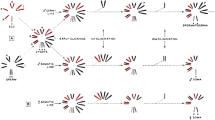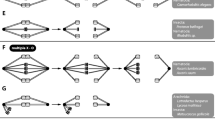Abstract
In meiosis I, homologous chromosomes combine to form bivalents, which align on the metaphase plate. Homologous chromosomes then separate in anaphase I. Univalent sex chromosomes, on the other hand, are unable to segregate in the same way as homologous chromosomes of bivalents due to their lack of a homologous pairing partner in meiosis I. Here, we studied univalent segregation in a Hemipteran insect: the spittlebug Philaenus spumarius. We determined the chromosome number and sex determination mechanism in our population of P. spumarius and showed that, in male meiosis I, there is a univalent X chromosome. We discovered that the univalent X chromosome in primary spermatocytes forms an amphitelic attachment to the spindle and aligns on the metaphase plate with the autosomes. Interestingly, the X chromosome remains at spindle midzone long after the autosomes have separated. In late anaphase I, the X chromosome initiates movement towards one spindle pole. This movement appears to be correlated with a loss of microtubule connections between the kinetochore of one chromatid and its associated spindle pole.






Similar content being viewed by others
References
Albertson DG, Thomson JN (1993) Segregation of holocentric chromosomes at meiosis in the nematode, Caenorhabditis elegans. Chromosom Res 1:15–26
Ault JG (1984) Unipolar orientation stability of the sex univalent in the grasshopper (Melanoplus sanguinipes). Chromosoma 89:201–205
Bauer H, Dietz R, Röbbelen C (1961) Die spermatocytenteilungen der tipuliden. III. das bewegungsverhalten der chromsomen in translokationheterozygoten von tipula oleracea. Chromosoma 12:116–189
Begg DA, Ellis GW (1979) Micromanipulation studies of chromosome movement I. Chromosome-spindle attachment and the mechanical properties of chromosomal spindle fibers. J Cell Biol 82:528–541
Boring, A. M. (1907). A study of the spermatogenesis in twenty-two species of the Membracidae, Jassidae, Cercopidae, and Fulgoridae (Doctor of Philosophy).
Boring AM (1909) A small chromosome in Ascaris megalocephala. Arch f Zellf 4:120–131
Boring AM (1913) The chromosomes of the Cercopidae. Biol Bull 24:133–146
Boring AM, Fogler RH (1915) Further notes on the chromosomes of the Cercopidae. Biol Bull 29:312–315
Boveri T (1909) Über geschlechtschromosomen bei nematoden. Arch f Zellf 4:132–141
Brady M, Paliulis LV (2015) Chromosome interaction over a distance in meiosis. R Soc open sci 2:150029
Bressa MJ, Papeschi AG, Mola L, Larramendy ML (2001) Autosomal univalents as a common meiotic feature in Jadera haematoloma (Herrich-Schaeffer, 1847) and Jadera sanguinolenta (Fabricius, 1775) (Heteroptera: Rhopalidae: Serinethinae). Eur J Entomol 98:151–157
Chmátal L, Gabriel SI, Mitsainas GP, Martínez-Vargas J, Ventura J, Searle JB, Schultz RM, Lampson MA (2014) Centromere strength provides the cell biological basis for meiotic drive and karyotype evolution in mice. Curr Biol 24:2295–2300
Dietz R (1954) Multiple geschlechtschromosomen bei dem ostracoden Notodromas monacha. Chromosoma 6:397–418
Dietz R (1969) Bau und funktion des spindelapparats. Naturwissenschaften 56(5):237–248
Doan RN, Paliulis LV (2009) Micromanipulation reveals an XO-XX sex determining system in the orb-weaving spider Neoscona arabesca (Walckenaer). Hereditas 146:180–182
Edwards CL (1910) The sex-determining chromosomes in ascaris. Science 31:514–515
Fabig G, Müller-Reichert T, Paliulis LV (2016) Back to the roots: segregation of univalent sex chromosomes in meiosis. Chromosoma 125:277–286
Fuge H (1985) The three-dimensional architecture of chromosome fibres in the crane fly II. Amphitelic sex univalents in meiotic anaphase I. Chromosoma 91:322–328
Forer A, Ferraro-Gideon, J, Berns, M (2013) Distance segregation of sex chromosomes in crane-fly spermatocytes studied using laser microbeam irradiations. Protoplasma 250:1045–1055
Golding AE, Paliulis LV (2011) Karyotype, sex determination, and meiotic chromosome behavior in two pholcid (Araneomorphae, Pholcidae) spiders: implications for karyotype evolution. PLoS One 6:e24748–e24748
Hamilton KGA (1982) Insects and arachnids of Canada: part 10. The spittlebugs of Canada (Homoptera: Cercopidae). Biosystematics Research Institute, Ottawa
John B (1990) Meiosis. Cambridge University Press, Cambridge
John B, Claridge MF (1974) Chromosome variation in British populations of Oncopsis (Hemiptera: Cicadellidae). Chromosoma 46:77–89
King JM, Nicklas RB (2000) Tension on chromosomes increases the number of kinetochore microtubules but only within limits. J Cell Sci 113:3815–3823
Kuznetsova V, Maryańska-Nadachowska A, Nokkala S (2003) A new approach to the Auchenorrhyncha (Hemiptera, Insecta) cytogenetics: chromosomes of the meadow spittlebug Philaenus spumarius (L.) examined using various chromosome banding techniques. Folia Biol 51:33–40
Montgomery TH (1910) Are particular chromosomes sex determinants? Biol Bull 19:1–17
Moore DP, Orr-Weaver TL (1998) Chromosome segregation during meiosis: building an unambivalent bivalent. Curr Top Dev Biol 37:263–299
Nicklas RB (1961) Recurrent pole-to-pole movements of the sex chromosome during prometaphase I in Melanoplus differentialis spermatocytes. Chromosoma 12:97–115
Nicklas RB (1963) A quantitative study of chromosomal elasticity and its influence on chromosome movement. Chromosoma 21:1–16
Nicklas RB, Brinkley BR, Pepper DA, Kubai DF, Rickards GK (1979) Electron microscopy of spermatocytes previously studied in life: methods and some observations on micromanipulated chromosomes. J Cell Sci 35:87–104
Nicklas RB, Staehly CA (1967) Chromosome micromanipulation. I. The mechanics of chromosome attachment to the spindle. Chromosoma 21:1–16
Nokkala S (1986) The mechanisms behind the regular segregation of autosomal univalents in Calocoris quadripunctatus (vil.) (Miridae, Hemiptera). Hereditas 105:199–204
Nokkala S, Kuznetsova V, Maryańska-Nadachowska A (2000) Achiasmate segregation of a B chromosome from the X chromosome in two species of psyllids (Psylloidea, Homoptera). Genetica 108:181–189
Rebollo E, Arana P (1995) A comparative study of orientation at behavior of univalent in living grasshopper spermatocytes. Chromosoma 104:56–67
Rebollo E, Martín S, Manzanero S, Arana P (1998) Chromosomal strategies for adaptation to univalency. Chromosom Res 6:515–531
Rebollo E, Arana P (1997) Univalent orientation in living meiocytes. Chromosomes Today 12:249–269
Rebollo E, Arana P (1998) Chromosomal factors affecting the transmission of univalents. Chromosom Res 6:67–69
Schrader F (1935) Notes on the mitotic behavior of long chromosomes. Cytologia 6:422–430
Shakes DC, Neva BJ, Huynh H, Chaudhuri J, Pires-da Silva A (2011) Asymmetric spermatocyte division as a mechanism for controlling sex ratios. Nature Comm 2:157
Shakes DC, Wu J, Sadler PL, LaPrade K, Moore LL, Noritake A, Chu DS (2009) Spermatogenesis-specific features of the meiotic program in Caenorhabditis elegans. PLoS One 5:e1000611
White MJD (1973) Animal cytology and evolution, Third edn. Cambridge University Press, Cambridge
Acknowledgments
We thank Art Forer for interesting discussions about our experiments and the implications of our results. We thank two anonymous reviewers for their constructive suggestions. KDF was funded by a Bucknell University Graduate Research Fellowship and a Robert P. Vidinghoff Memorial Summer Internship through the Bucknell University Biology Department. NAR was funded by the Russo Fund for Undergraduate Research in Biological Sciences through the Bucknell University Biology Department. MBL and LQ were funded by the National Science Foundation (grant number NSF DUE-1317446).
Author information
Authors and Affiliations
Corresponding author
Ethics declarations
All applicable international, national, and/or institutional guidelines for the care and use of animals were followed. This article does not contain any studies with human participants performed by any of the authors.
Conflict of interest
The authors declare that they have no conflict of interest.
Additional information
Handling Editor: Douglas Chandler
Rights and permissions
About this article
Cite this article
Felt, K.D., Lagerman, M.B., Ravida, N.A. et al. Segregation of the amphitelically attached univalent X chromosome in the spittlebug Philaenus spumarius . Protoplasma 254, 2263–2271 (2017). https://doi.org/10.1007/s00709-017-1117-9
Received:
Accepted:
Published:
Issue Date:
DOI: https://doi.org/10.1007/s00709-017-1117-9




